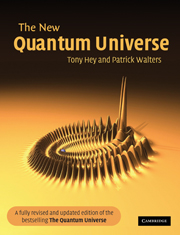Book contents
- Frontmatter
- Contents
- Preface
- Prologue
- Route map
- 1 Waves versus particles
- 2 Heisenberg and uncertainty
- 3 Schrödinger and matter waves
- 4 Atoms and nuclei
- 5 Quantum tunnelling
- 6 Pauli and the elements
- 7 Quantum co-operation and superfluids
- 8 Quantum jumps
- 9 Quantum engineering
- 10 Death of a star
- 11 Feynman rules
- 12 Weak photons and strong glue
- 13 Afterword – quantum physics and science fiction
- Epilogue
- Appendix 1 The size of things
- Appendix 2 Solving the Schrödinger equation
- Glossary
- Quotations and sources
- Suggestions for further reading
- Photo-credits
- Name index
- Subject index
7 - Quantum co-operation and superfluids
Published online by Cambridge University Press: 05 October 2013
- Frontmatter
- Contents
- Preface
- Prologue
- Route map
- 1 Waves versus particles
- 2 Heisenberg and uncertainty
- 3 Schrödinger and matter waves
- 4 Atoms and nuclei
- 5 Quantum tunnelling
- 6 Pauli and the elements
- 7 Quantum co-operation and superfluids
- 8 Quantum jumps
- 9 Quantum engineering
- 10 Death of a star
- 11 Feynman rules
- 12 Weak photons and strong glue
- 13 Afterword – quantum physics and science fiction
- Epilogue
- Appendix 1 The size of things
- Appendix 2 Solving the Schrödinger equation
- Glossary
- Quotations and sources
- Suggestions for further reading
- Photo-credits
- Name index
- Subject index
Summary
… there are certain situations in which the peculiarities of quantum mechanics can come out in a special way on a large scale.
Richard FeynmanLaser light
Nowadays, everyone has heard of lasers, and laser light displays are a frequent ingredient of modern rock concerts. Laser light has many applications, ranging from astronomy to hydrogen fusion. What is the special feature of laser light that makes it so useful? The answer to this question involves a property of wave motion known as ‘coherence’, with light photons acting together in a special form of quantum mechanical co-operation. This type of quantum co-operation will turn out to be vital for an understanding of the peculiar behaviour of quantum ‘superfluids’. To understand the special nature of laser light, however, we must first explain what is meant by coherence.
Consider the simple wave motion shown in Fig. 7.1. We see that the pattern repeats itself after one wavelength and the frequency of the wave corresponds to the number of wavelengths sent out per second. If this wave is a wave on a string, each point on the string just moves up and down with a certain amplitude: the maximum distance the point can move out to before it starts to come back. Up to now, this is really all we have needed to know about waves. Now consider two waves of the same wavelength but started at slightly different times, as shown in Fig. 7.2.
- Type
- Chapter
- Information
- The New Quantum Universe , pp. 131 - 156Publisher: Cambridge University PressPrint publication year: 2003



